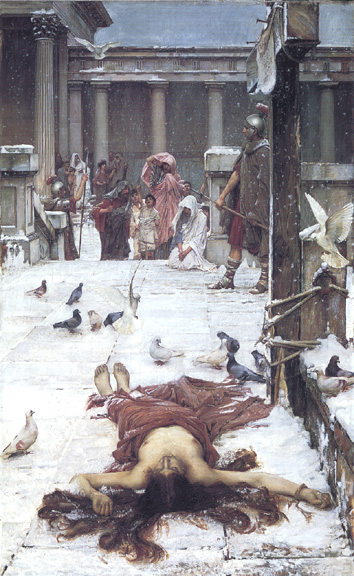"Noble of stock, and nobler still in the quality of her death, the holy maid Eulalia honours with her bones and tends with her love her own Emerita, the town that gave her birth. Far in the west lies the place that has won this signal honour; as a city, great and populous, but greater through the blood of martyrdom and a maiden's tombstone."
Prudentius, Peristephanon (III.1-10)
Filled with an ardor for martyrdom, Eulalia was a girl of twelve when she refused to sacrifice to the pagan gods, rebuking the local magistrate for his iniquity. Even when the instruments of torture were placed before her, which she would be spared if only she were to offer a bit of salt and incense, Eulalia was defiant. Cruelly tortured, her breasts and body torn to the bone with iron hooks and then burned with torches, she died when her hair caught fire, suffocated by the smoke and flames. From her mouth, a white dove was seen to come forth and ascend into heaven.
Eulalia was martyred in AD 304, the year Diocletian promulgated his fourth edict against the Christians, requiring sacrifice to the gods, although it may have been the year before, when the first of these edicts was issued. Her feast day is December 10.
Saint Eulalia by John William Waterhouse (1885) tactfully avoids the disfigurement of torture and instead presents the supine girl as if asleep, her garment and auburn hair representing the flayed skin and spilled blood against the purifying snow, which is said to have fallen to cover the exposed body. Her saintly triumph is celebrated by the palms being waived in the background and the doves which flutter above her. Still, given the torments related by Prudentius, it is a discomfiting portrayal. The classical and religious themes of the painting resonated with the Victorian audience; indeed, Waterhouse was elected an associate of the Royal Academy immediately after the picture was displayed. But, in gazing at the vulnerable girl, still bound at the foot of the cross and lying virginal and half naked in the snow, there is a voyeuristic quality that undercuts the painting's edifying content.
Drawing on oral tradition, Prudentius is the first to relate the story of Eulalia, fitting it into the Christian tradition of a young virgin's martyrdom. In her journey from home to return to town, where she remonstrates with the magistrate, there also is the notion of her as epic hero, a theme drawn both from Virgil's Aeneid as well as the flight from Egypt in the Old Testament.
These incidental quotations from the church fathers place the death of Eulalia in a context of willing martyrdom, and the glorious salvation thought to be its reward.
"But in his [Melito] book addressed to the emperor [Marcus Aurelius] he records that the following events happened to us under him: 'For, what never before happened, the race of the pious is now suffering persecution, being driven about in Asia by new decrees. For the shameless informers and coveters of the property of others, taking occasion from the decrees, openly carry on robbery night and day, despoiling those who are guilty of no wrong.' And a little further on he says: 'If these things are done by thy command, well and good. For a just ruler will never take unjust measures; and we indeed gladly accept the honor of such a death.'"
Eusubius, Church History (IV.26.5)
"For I myself, too, when I was delighting in the doctrines of Plato, and heard the Christians slandered, and saw them fearless of death, and of all other-things which are counted fearful, perceived that it was impossible that they could be living in wickedness and pleasure. For what sensual or intemperate man, or who that counts it good to feast on human flesh [a charge brought against the Christians in their celebration of the eucharist] could welcome death that he might be deprived of his enjoyments, and would not rather continue always the present life, and attempt to escape the observation of the rulers; and much less would he denounce himself when the consequence would be death?"
Justin Martyr, Second Apology (XII)
"The place to the right is for others who have already pleased God, and have suffered for His name's sake; and you have yet much to accomplish before you can sit with them. But abide as you now do in your simplicity, and you will sit with them, and with all who do their deeds and bear what they have borne....'What have they borne?' said I. 'Listen,' said she: 'scourges, prisons, great tribulations, crosses, wild beasts, for God's name's sake. On this account is assigned to them the division of sanctification on the right hand, and to every one who shall suffer for God's name: to the rest is assigned the division on the left. But both for those who sit on the right, and those who sit on the left, there are the same gifts and promises; only those sit on the right, and have some glory.'"
Hermas, The Pastor (III.1; 2.1-2)
References: Prudentius on the Martyrs (1989) by Anne-Marie Palmer; J. W. Waterhouse (2002) by Peter Trippi; The Suffering Self: Pain and Narrative Representation in the Early Christian Era (1995) by Judith Perkins; Poetry and the Cult of the Martyrs. The "Liber Peristephanon" of Prudentius (1993) by Michael J. Roberts; Prudentius: Crowns of Martyrdom (1953) translated by H. J. Thomson (Loeb Classical Library); A Select Library of Nicene and Post-Nicene Fathers of the Christian Church, Series II (Vol I: Eusebius) (1890-1896) edited by by Philip Schaff and Henry Wace; The Ante-Nicene Fathers: Translations of the Writings of the Fathers Down to A.D. 325 (Vol I: Justin Martyr, Vol II: Hermas) (1885-1896) translated and edited by the Rev. Alexander Roberts and James Donaldson.
